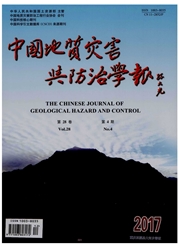

 中文摘要:
中文摘要:
利用FLAC模拟了两个不同直径圆形隧洞的剪切应变局部化过程。为了模拟隧洞开挖,利用编写的FISH函数删除隧洞内部的单元。岩石服从莫尔库仑剪破坏与拉破坏复合的破坏准则,破坏之后呈现应变软化-理想塑性行为。本文的模拟分为3步:首先,将静水压力施加在模型上,直至达到静力平衡状态;然后,利用编写的FISH函数,开挖隧洞;最后,计算重新开始,直至达到静力平衡状态(对于小孔隧洞)或者塑性流动状态(对于大孔隧洞)。模拟结果表明,多个“狗耳”形或V形坑在小孔隧洞周边附近产生,最终,围岩处于平衡状态。这一结果与陆家佑和王昌明(1994)的实验结果及许多现场观察结果一致。对于大孔隧洞,由于在围岩中出现了多条剪切带,因而隧洞的整个断面均遭到了破坏。这一现象与现场观察到的猛烈破坏现象类似。隧洞的剪切应变局部化受隧洞尺寸的影响。
 英文摘要:
英文摘要:
Shear strain localization processes of two circular tunnels with different diameters are modeled by use of FLAC. To model excavation, a FISH function is written and used to delete elements in tunnels. Rock elements exhibit linear strainsoftening behavior beyond the occurrence of failure and then the ideal plastic behavior. A composite Mohr-Coulomb criterion with tension cut-off is used. The present calculation is divided into three steps. Firstly, a hydrostatic pressure is applied to the plane strain model until a static equilibrium state is reached. Secondly, a tunnel is excavated using the written FISH function. Thirdly, the calculation renews to achieve a new equilibrium state for the small tunnel or a plastic flow state for the big tunnel. Results show that dog-ear or V-shaped notches are generated in the vicinity of the small hole and finally the surrounding rock reaches an equilibrium state. The result is consistent with the experimental result by Lu and Wang(1994) and many observations in situ. For the big tunnel, the entire section of the tunnel is destroyed since many shear bands are observed in the surrounding rock. The phenomenon is similar to the violent failure phenomena in situ. The obtained results show that shear strain localization is dependent on the size of the tunnel.
 同期刊论文项目
同期刊论文项目
 同项目期刊论文
同项目期刊论文
 期刊信息
期刊信息
